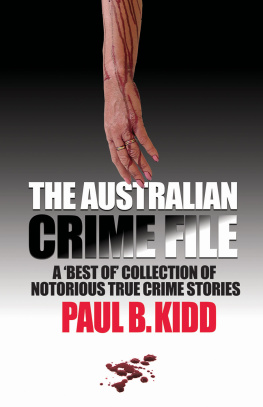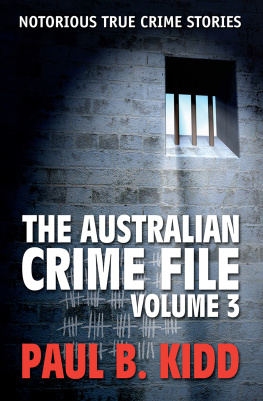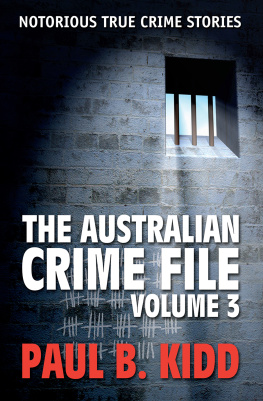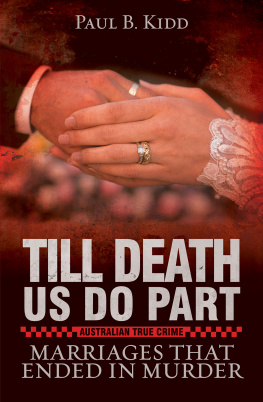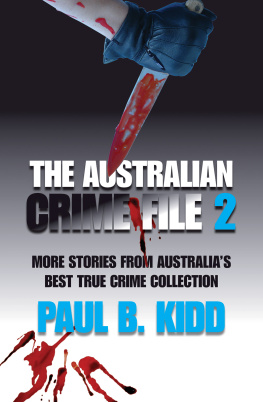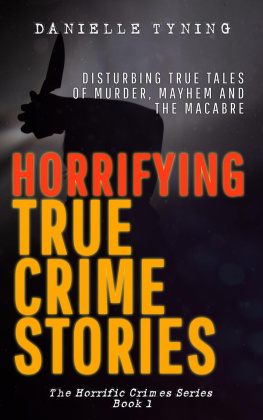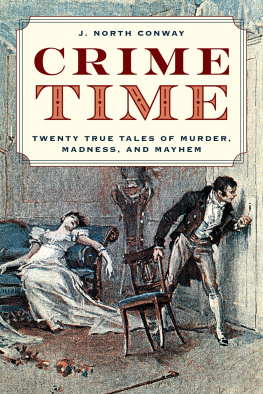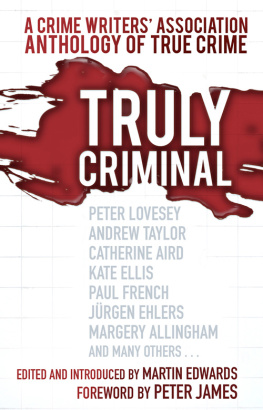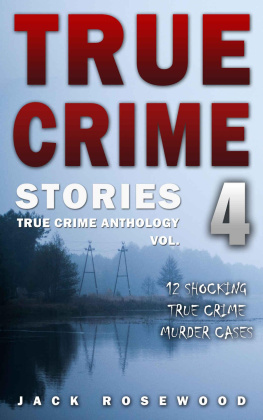The Australian Crime File
A Best of Collection of Notorious True Crime Stories
Paul B. Kidd
For George Moore, my Radio 2UE on-air partner, who I believe is the most professional person I have ever worked with in any form of the media. So George, now you have everything. I mean, how many people do you know who can say theyve had a book dedicated to them?
And, as always, for my son Ben. The best bloke Ive ever known.
Contents
Introduction
When I first teamed up with top-rating radio broadcaster George Moore in October 2001 to do the Summer Weekend Show on Sydneys Radio 2UE, neither of us realised just how successful the show would become.
Within weeks the ratings were through the roof and we eventually wound-up doing what has now become known as The Weekend Show all year round, from 16 pm on Saturday and Sunday afternoons. And thats how it is today.
There are too many individual reasons to list that have contributed to The Weekend Show s success. But from listener response, there is little doubt that our weekly Crime File segment is one of them.
Each Sunday, just after 4 oclock, we present a 10 to 15 minute abbreviated version of a famous (or, sometimes, not so well known) Australian crime. I read it out, George interjects from time to time with queries and, at the end, we discuss various aspects of the case. Then the listeners ring us up and have a chat about it.
Over the years we have looked at more than 140 cases, and for this book I have chosen 90 cases that I consider to be the most interesting for the Australian true crime enthusiast. Hence the subtitle A Best of Collection.
This is not a reference book such as Australias Serial Killers or the Never To Be Released series in which the criminals are catalogued according to the nature of their crimes or the sentences they received. And for this reason you will find that the stories in this book are not in chronological or alphabetical order.
Personally, unless a book is a reference book as the aforementioned are, I dont like reading a book of stories especially crime stories that goes back into history, starts at the beginning and ends in the modern day.
My preference is to go from the old to the new (or vice versa) and then back to the old again, from one type of crime to another, from a long story to a short one. These are the books I find most interesting, and for this reason The Australian Crime File is a mix of the old and the new and the long and the short. I trust my selection of the order of the chapters is to your liking.
The other thing that this book allows me is the luxury of writing the stories as long or as short as I desire. A lot of them are about the length of a story that I would read out on air say, around 1000 words, or 10 minutes or so of talking time. But with many of the others I have been able to indulge myself and tell the story in its entirety and not leave out anything as I have had to do when narrating it on the radio.
For example, the first story in this book is an exclusive interview I scooped with the prime suspect in the Claremont Serial Murders a few years back. The interview itself is quite long and could not be told in any other way than its entirety. When I did the same story on the radio I could only deal with the story of the murders themselves and couldnt fit in any part of the interview. Time simply didnt allow. Now the story appears in this book as it shouldin its entirety.
Other favourites of mine are Who Killed Mr Rent-a-Kill?, which is the story behind the demise of Christopher Dale Flannery, Australias most notorious hitman; The Kangaroo Gang, which tells of the Australian gang of shoplifters who cleaned out Londons department stores like a pack of locusts in the 1960s; and Harvey Jones Bones, which is the story of a skeleton that came back to haunt one of Australias most notorious gangsters, eventually putting him away for life.
The Australian Crime File also deals with the macabre and the unusual. The Case of the Walking Corpse tells of a serial killer whose last victim was buried in the killers place by mistake; the killer got off scot-free until he was spotted walking down the street by an old workmate who had been to his funeral.
And, in The Kingsgrove Slasher police hunt down one of the most feared beasts in Sydneys criminal history only to find he is exactly the opposite to what they imagined.
And, in The Mysterious Eugenie Fellini, what could be more bizarre than when police captured a murder suspect after a long search only to find that the man they had arrested didnt have all the right bits and was in fact Well, youll have to read the chapter to find out.
Yes, these and many, many more tales of Australian crime are in this book, which I believe will become one of the Australian true-crime buffs best bedside books of all time.
Paul B. Kidd
Sydney, 2005
The Claremont Serial Murders
In November 2000, author Paul B. Kidd went to Perth to interview the main suspect in Western Australias notorious unsolved serial murder mystery. This is the interview and the background to one of Australias most enduring mysteries.
I think of myself as the fourth victim in all this, says the prime suspect in the baffling abductions of three young women from a Perth nightspot the Claremont Serial Murders.
One minute I was sitting quietly in my car, the next thing I knew it was full of police and someone put a swab into my mouth and took a sample of my saliva. And then, after the police questioned me for almost 13 hours, took my car away and searched my apartment from top to bottom, they put me under 24-hour surveillance, he says, without the slightest hint of malice. And they didnt do anything to disguise the fact that they were following me either.
Whenever I was home two detectives sat in a car across the road, and when I went out they followed me everywhere, day and night. They followed me to work and waited out front until I had finished for the day and then followed me home, he says.
One day the ceiling above my office showed signs of falling in, and when I stood on a chair to have a look I found a surveillance device hidden in there. For 18 months I couldnt make a move without them being there. But they seem to have gone away now. I havent seen them in months.
Perths most infamous man lets call him George certainly doesnt look like an abductor and murderer of young women. Not that theres a stereotype for Australias serial killers. John Glover, for example, the Granny Killer, was a rotund 60-year-old pie salesman; the Backpacker Murderer, Ivan Milat, 38, was a stocky, well-built road worker with a large Merv Hughes moustache; and Paul Denyer, 21, the Frankston Serial Killer, was an obese, unemployed oaf who answered to the nickname John Candy (after the late film star).
In contrast, the prime suspect in the Claremont serial murders is conspicuous by his ordinariness. Ironically, the crimes of which he is suspected are far from ordinary. Between January 1996 and March 1997 three attractive young women vanished from the periphery of fashionable Claremonts ritzy hotel and coffee lounge strip, which caters for patrons until the small hours of the morning. Claremont is a 20-minute drive from the heart of Perth.
The only connection detectives could establish between the women was that at some stage during the evening of their disappearances they had been at, or in the vicinity of, the Continental Hotel, a popular late-night drinking haunt opposite the railway station, and the cornerstone of the strip.

